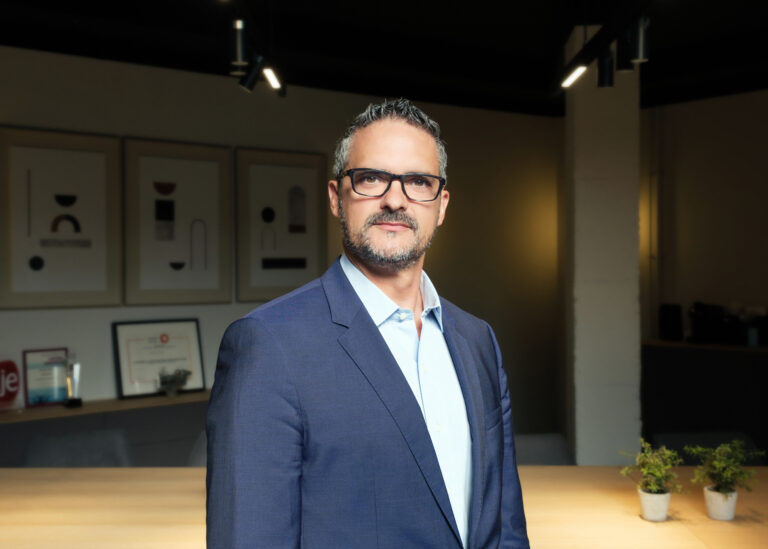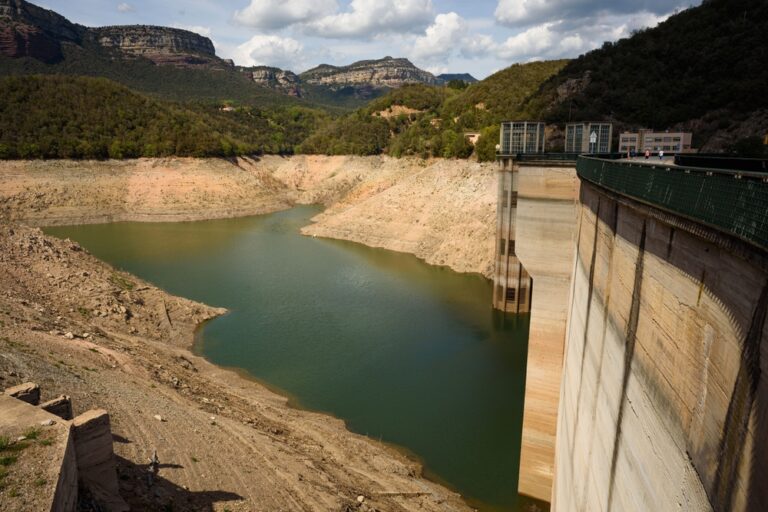Words of Wisdom from Emerald’s Advisory Council – Carlos Campos
Carlos Campos, environmental solutions leader, discusses the multifaceted challenges of climate change on water resources with Emerald Partner Helge Daebel. With the dual threats of extreme drought and extreme flooding, this conversation underscores the necessity for proactive, technology-driven approaches to ensure sustainable water management, not only for our cities, but also across the industrial sector as a whole.

Dealing with droughts and floods
Helge: Climate change is upon us. What challenges in the water space are intensifying because of this?
Carlos: We have extreme drought events, of course. So there is always talk of water availability and drinking water, etc. But many of the damages and risks that we have with water are from having too much water. There is extreme flooding in many places. We must take this twofold view. On the dry side, there are the areas where 1.5 degrees Celcius more is going to result in no water or less quality water. And on the wet side, there will be too much rain and no infrastructure to contain this flooding.
Helge: What are the consequences of this that you have seen?
Carlos: Regarding the droughts, in cities like Barcelona, after two annual cycles of less snow than usual, there will be guaranteed water restrictions for a population of around 5 million people in the Catalonian internal basins. And reductions up to 30% of consumption in many industries. Regarding flooding, many countries have not put in place the funding mechanisms to take care of the infrastructure needed to prevent floods damages. For drinking water production and wastewater treatment, there is a utility; we have a tariff. Everything is put in place to pay for the infrastructure and services. And the taxpayer pays for that. But for flooding protection – who pays for that infrastructure? The city through an additional tax? Should it be included in the water bill? The whole institutional setup is not put in place in most countries to tackle the flooding problem.
Helge: But there is also an effect on the infrastructure itself, right? If you have a region with big swings between too little and too much, this has an impact on your soil, and it has an impact on potential shifts of your infrastructure. And then let’s assume you’re facing a drought situation and therefore, as a utility, you have to adjust, or you have to basically mandate certain consumption behavior. It means that you will likely run your system differently than you planned to run it. So then again, you have issues in your piping network. In both cases, it means the costs to manage your system go significantly up.
Carlos: Exactly. This is especially true in sewer systems that have to be operated with less carrying water during drought periods.
Helge: No one can afford these costs, so we need to be extremely smart. Do you think it is more about how we detect potential issues and how we prioritize the investment amount? Or do you think it is more direct, like the flood issue where technology can make a difference?
Carlos: If we sort out how we fund the solutions, then we can ask, do we have the technology to do that? Currently, we can use devices to predict storm events, measure the water levels, anticipate the damage and thus run storm water management systems in a “better” way. But technologically speaking, there’s still room for developments. We have very sophisticated tools in some cities (smart digital solutions); however, we still operate the systems by just waiting for the storm to come. And then we open and close valves.

Helge: And tropical weather conditions have very different requirements than what we have in Europe.
Carlos: Surely. Storm patterns, with the associated intensity and frequency, are different. And digital solutions can bring part of the solution. As sensors become cheaper and connectivity becomes a standard for utilities, we will have systems that run seamlessly when they face a storm. This is not the case for most of the cities from the drought point of view.
Securing water availability and water quality with technology
Helge: The technology needs to be implemented, but it also needs to be adopted, as you mentioned. What else do we need to consider when it comes to adapting to climate change?
Carlos: Regarding securing water availability, the first step is that people must consume less. And when I say people, I mean in industry, cities and agriculture. And to consume less water, we need to be able to measure that water, aggregate the data, and then arbitrate the uses. This requires technology, and we’re not there yet. With the many competing for uses of water, from citizens to industry to food and agriculture, technologies must be put in place that focus on measuring the demand side and introducing efficiencies in their uses. You can see this in all water stressed regions, from where I live in Spain, to California and Australia. Once quantity is secured, we have to deal with quality. We must start utilizing water sources that are poorer in quality – sources that we never used before because we had other, better resources. Imagine a reservoir. As you empty a reservoir, you concentrate all the bad quality on the bottom. When this is the only water that is left, you must treat this water, the worst water that you could imagine. We’ve never had to treat such low-quality water before because there was always enough water with better quality. Well, this is what is happening now, which brings additional treatment costs that have to be reflected in the final price.
Helge: The lower level of a sedimentation tank, almost.
Carlos: Metals, synthetic organic compounds like PCBs – all that pollution is in the sediments, and you have to pump it, treat it and in some cases even transfer cleaner water to dilute that water. This happened during the drought period in some reservoirs in Spain. We will inevitably need to go after water sources that do not have enough quality for drinking water production. So then automatically, technologically speaking, you have to put additional technology in the plants.
Helge: And you need to operate it smartly.
Carlos: Yes, we’re going to have plenty of challenges with PFAS, microplastics, etc. Because these are the water sources that exist, and we have no choice. We have to use them, regenerate them. In many places there will be no other sources.
Helge: If you look at a reservoir, it clearly accumulates a lot of stuff over time that would otherwise be in much lower concentrations.
Carlos: We tend to think that reservoirs are an empty basin. But actually, it accumulates sediment over centuries. And now we’re getting to that point. For instance, in the Barcelona supply basin, reservoirs reached less than 15% of their reserves during the peak of the drought. They were literally scraping the bottom of the reservoirs!
Helge: That’s public knowledge. That 15%.

Carlos: You have the reservoir levels on the television every day to sensitize the population to water conservation practices. It’s a real challenge and it’s directly derived from climate change. Another issue that needs to happen due to climate change is dealing with soils that are following wet-dry, wet-dry cycles, and how this impacts infrastructure. We never operated infrastructure under those conditions. That means we’re going to have infrastructure deteriorating at a faster pace and then generating leaks, generating operational issues. This is where companies that are proactive in detecting these aging and degradation mechanisms have a lot of value because then you can replace before they break. This is what we call Preventive Management, and we see technology arising for it.
Helge: We already had an aging infrastructure problem without climate change. This makes it even more pronounced. Then, operationally, to cut consumption drastically, you need to pump less water through the system, but also make better efforts on water efficiency and leakage and keep the network condition at the highest standard possible.
Carlos: And one important point – urban water is globally 5% to 8% of the water we use. Industrial water use is 10-15% and then the rest is agricultural water (up to 80%). If we take a look at the industries in places under water stress, they will have to rethink their whole water process to reduce consumption significantly by 10% to 30%. You can’t do that by just optimizing your consumption. You have to rethink your whole process.
Helge: And rethinking with a different lens. Because before you didn’t look at your process with a water lens. But now this has become a major risk factor. And only now, through this, water is being seen at the right value. Slowly, but surely. We see it with our portfolio companies, the value that some of the corporates are willing to pay for amounts of water. It goes beyond what you would ask as a utility from consumers to pay.
Carlos: If a big corporation like Microsoft or Google, big water users, want to install a facility in a place that’s under water stress, they have no choice. They will not receive authorization to run that facility unless they offset the water consumption.
Getting into water reuse
Helge: Besides what we’ve already covered, are there other technology opportunities that could help?
Carlos: Water reuse. Circularity in urban, as well as in industry, but we need also to work on the public acceptance. For instance, in urban, I could be recycling my own water, but I don’t want to be recycling my neighbor’s wastewater. So, in order for this to be accepted by the population, we need as an industry to ensure that direct reuse is real and safe. One way to do this is monitoring online. We currently don’t monitor online for bacteria. But this will be imperative because we want to know that our systems and our barriers are stopping viruses, bacteria and protozoa. And so, monitoring online is going to be an imperative, and it will be regulated in the future. And second, treatments that exist today must be disseminated in a decentralized way, because recycling and reuse and regeneration of water will not be centralized in many places.

Helge: Economically it doesn’t make sense. Water must be reused locally.
Carlos: Exactly. Cities will need buildings with units to recycle the grey water and use it for grey uses. And this is, technologically speaking, an opportunity for companies that are creating compact systems that are designed for small volumes.
Helge: It’s one thing to have online monitoring to give the consumer the certainty that everything is okay. But let’s not forget wastewater treatment. The initial reason why it was established was for public hygiene. So, you and I, we shouldn’t run our own decentralized wastewater treatment facility. Because the public authorities could run into severe health issues within the population if that was the norm. You need a proper operator that takes care of distributed assets, has the right sensors and detection mechanisms to predict failure, and to continuously monitor the quality of the water 100%.
Carlos: My point is that reclaimed water will be distributed two ways. One is centralized in a big wastewater water reclamation plan. And then you need a dual network to bring the regenerated water back to your backyard and irrigate the gardens, etc. Those networks will need to have continuous monitoring, as well.
Helge: Because there will be mistakes.
Carlos: So monitoring the water quality will be key. Both California and Singapore did a terrific job with demonstration projects to make people understand that if you’re going to be reclaiming water, then that water needs to be redundantly safe. This was not possible 30 years ago. Today this is possible with the proper monitoring and the proper treatment for this reclaimed water.
Water and the bottom line
Helge: And are new regulations also impacting how corporates are dealing with water management?
Carlos: The new directive from Europe (CSRD) is mandating sustainability reporting. One indicator they use is the impact that you’re doing to the natural world.
Helge: How much water the corporate takes out of nature. And how dependent they are on water?
Carlos: Exactly. And what is the risk of not having that resource? They will all be impacted – food & beverage and pharma – all industries using water as part of their production processes.
Helge: One comment I really liked recently from Global Water Intelligence (GWI) is that the water topic has moved from the sustainability officer to the CFO. Things are moving faster now.
Carlos: This is true. Sustainability topics start to accelerate when they hurt the bottom line. Now is that time for water.
More on investing in water & wastewater:
Tech you should know about: AI-based sustainable irrigation & volumetric water benefits
Emerald marks first India investment with water treatment vanguard INDRA
